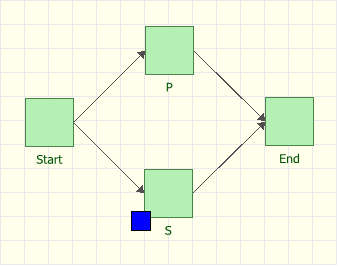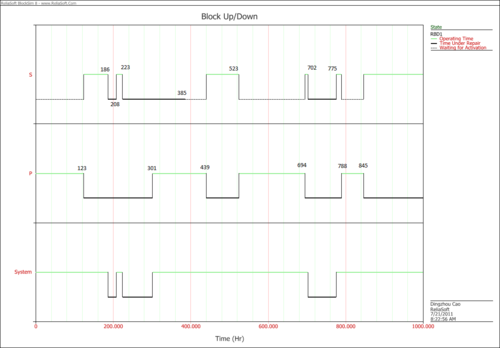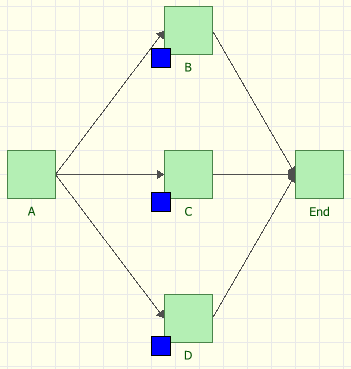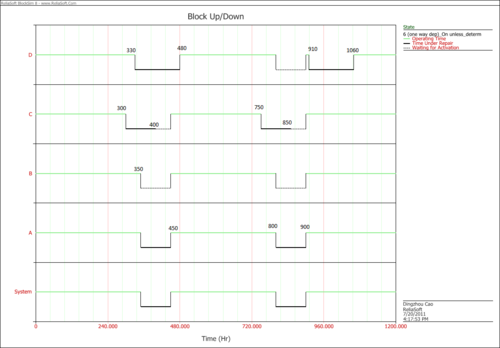BlockSim Example: Default ON unless SCT Overridden: Difference between revisions
Dingzhou Cao (talk | contribs) |
Dingzhou Cao (talk | contribs) |
||
| Line 4: | Line 4: | ||
== Default ON unless SCT Overridden== | == Default ON unless SCT Overridden== | ||
=== Purposes === | |||
The purposes of these examples are to illustrate the option Default ON unless SCT overridden in SCT settings. Two cases are presented for illustration purpose. | The purposes of these examples are to illustrate the option Default ON unless SCT overridden in SCT settings. Two cases are presented for illustration purpose. | ||
Revision as of 17:02, 21 October 2011
Default ON unless SCT Overridden
Purposes
The purposes of these examples are to illustrate the option Default ON unless SCT overridden in SCT settings. Two cases are presented for illustration purpose.
Example 1
This example is used to illustrate the following options in SCT:
- State Upon Repair: Default ON unless SCT overridden
- Activate a block if any item from these associated maintenance group(s) goes down
- Deactivate a block if any item from these associated maintenance group(s) is restored
BlockSim Solution
Consider a system shown in Figure below:
Block P is the primary device. It belongs to maintenance group P.
Block S is the standby device. It has state change triggers. The initial state is OFF. If Block P goes down, then activate this block; if Block P is restored, then deactivate this block. The State Upon Repair is “Default ON unless SCT Overridden”.
Both Block P and S have Weibull distribution with Beta=1.5 and Eta=100 for reliability and repair action.
Both Block P and S are as good as new after repair.
Block Up/Down plot
The Blocksim modeling of this system is shown in Figure below.
- At 123, Block P fails and activates Block S.
- Block S fails at 186 and is restored at 208. According to setting, it is ON upon repair.
- At 223, Block S fails again.
- At 301, Block P is restored, and put a request to deactivate Block S. However, Block S is down for repair at this point. The request overwrites the default setting "state upon repair" of Block S. Thus when Block S is done with repair at 385, it is OFF.
- At 439, Block P fails and activates Block S.
- At 523, Block P is restored and deactivates Block S.
- At 694, Block P fails and activates Block S.
- At 702, Block S fails and it is get repair at 775. According to setting, it is ON upon repair.
- At 788, Block P fails and activates Block S.
- At 845, Block P is restored and deactivates Block S.
Example 2
This example is used to illustrate the following options in SCT:
- State Upon Repair: Default ON unless SCT overridden
- Deactivate a block if any item from these associated maintenance group(s) goes down
- Activate a block if any item from these associated maintenance group(s) is restored
BlockSim Solution
Consider a system is shown in the Figure below.
Block A fails every 350 hours and the duration for the repair action is 100 hours. It is restored as good as new. It belongs to maintenance group A. Block B cannot fail. It has state change triggers. The initial state is ON, and the state upon trigger is "Default On unless SCT overridden". If any item from maintenance group A goes down, this block is deactivated; if any item from maintenance group A is restored, this block is activated. Block C fails every 300 hours and the duration for repair action is 100 hours too. It is restored as good as new. It has state change triggers. The initial state is ON, and the state upon trigger is "Default On unless SCT overridden". If any item from maintenance group A goes down, this block is deactivated; if any item from maintenance group A is restored, this block is activated. Block D fails every 330 hours and the duration for repair action is 150 hours too. It is restored as good as new. It has state change triggers. The initial state is ON, and the state upon trigger is "Default On unless SCT overridden". If any item from maintenance group A goes down, this block is deactivated; if any item from maintenance group A is restored, this block is activated. Block A, C and D all are as good as new after repair.
Block Up/Down plot
The system behavior for simulation of 1200 hours durations is shown in Figure below and explained next.
- At 300 and at 330, Block C and D fail respectively.
- At 350, Block A fails, it brings system down, turns Block B OFF and also puts a request to turn Block C OFF. However, Block C is down for repair at this time, thus after Block C is done with repair, the trigger will overwrite the default setting (default ON unless overridden) of Block C and C is stay OFF upon repair.
- At 450, Block A is restored, which activate Block B and C. Block D is still down for repair at this point, thus nothing happen to Block D.
- At 480, Block D is restored. According to setting, D is ON upon repair.
- At 750, Block C fails.
- At 800, Block A fails, and deactivates Block B and D. And it also put a request to turn Block C OFF. However, Block C is down for repair at this point, the state upon repair of Block C is overridden. Thus when Block C is done with repair at 850, it keeps stay OFF.
- At 900, A is restored, and activates Block B, C and D.
- From 910 to 1060, Block D fails and get repair. There is not trigger in this period, thus it is ON upon repair.



